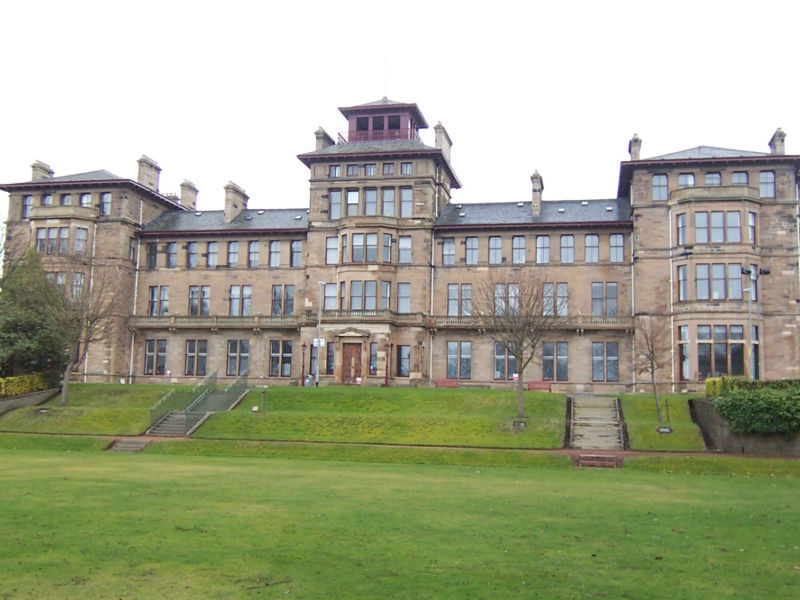
In June 1917, shell-shocked and exhausted from his experiences on the Western Front, the young English poet Wilfred Owen was sent to Craiglockhart War Hospital in Edinburgh to recuperate.
Much of our awareness of Owen’s time at Craiglockhart comes from Pat Barker’s beautifully crafted novel Regeneration (1991), and Stephen MacDonald’s play Not About Heroes (1982). MacDonald’s work focused mainly on the relationship between Owen and fellow soldier-poet Siegfried Sassoon, while Barker focused on Sassoon and Craiglockhart psychiatrist William Rivers. Both works are to be commended, but they are essentially fictional accounts.
Part of the hospital’s plans to restore traumatised British officers to health was to put these men to work in the professions they knew. For Owen, this would include teaching English at Tynecastle High School, returning him to the reassuring rhythms of work routines.
Capital interest
This sparked my interest to find out more about Owen’s time in Edinburgh. Who did he meet, where did he go, what influenced him, what did he write? What started as amateur history research expanded, and now I chair Wilfred Owen’s Edinburgh 1917-2017, a literary community celebrating the centenary of the poet’s time in Edinburgh.
Looking at Owen through the lens of the city has led to a decade of research and thrown up some interesting questions. Not least about the meeting between Wilfred Owen, Siegfried Sassoon and Robert Graves, who would be recorded in history as three of the greatest World War I poets.
Sassoon was also a patient at the hospital, and fellow officer Graves was a great friend who visited him in Edinburgh during his convalescence. The two would survive the war and write autobiographies of their experiences – Sassoon, Memoirs of An Infantry Officer, and Graves, Goodbye To All That.
Finding Owen
I was fascinated with this meeting. But one of the major challenges of researching Owen is that most of the archival material is held in the US. Early trips established the facts, but crucially, I was looking to identify the scene of the Edinburgh meeting in October where Owen, Sassoon and Robert Graves held what has been described as “a powerful literary meeting”.
Seeking this place compelled me to return to Owen’s letters held at the University of Texas. It was here I learned of a new publication: Carol Rothkopf’s Selected Letters of Siegfried Sassoon and Edmund Blunden, 1919–1967 (2012).
Letters between the two men in 1936 spoke of the important Owen-Sassoon-Graves Edinburgh meeting on October 13, 1917. The venue was not revealed, but there was mention of a “2½ miles” distance to the place. So I got in my car and drove to Edinburgh to check it out. I had a hunch that the meeting took place at Baberton Golf Club on the west of Edinburgh – Oxford-based scholar and Owen biographer Dominic Hibberd first floated this suggestion in 2003, but it was never corroborated.
A hole in one
Returning to Edinburgh, I checked maps of the era again to confirm there was no other route between Craiglockhart War Hospital and Baberton Golf Club than the two roads which still exist today. Again I checked the distances. Both routes sat just outside the 2½ miles talked about in the 1936 letter. Another dead end. Then in February 2017 I went back over all the emails I had sent to archives about this historic poetic meeting, and finally everything fell into place.
Southern Illinois University held many of Sassoon’s letters from the Great War, and eight years after I had first been in touch, I renewed my quest, homing in on a specific letter between Sassoon and Graves. And there it was: Sassoon arranging to meet Graves at Baberton Golf Club, 2¾ miles from Craiglockhart Hospital. The venue was simply chosen because Sassoon had a golf tie that morning which he could not cancel, so he asked Owen to bring Graves to the club.
This meeting of arguably the greatest war poets of World War I happened only once. But clearly, Owen made an impact on Sassoon’s friend Graves, for he was invited to the young captain’s wedding the following January.
More importantly, the discussion between the three may also have been profoundly inspiring. Owen’s biographers, Dominic Hibberd and Jon Stallworthy, claimed that the friendship fostered with Sassoon at Craiglockhart accelerated Owen’s poetic development. But this meeting at Baberton brought together three young poets deeply affected by their shared experience of war. The timing of Dulce et Decorum est, Owen’s shocking poem about a gas attack is not without significance; the 24-year-old officer wrote it two days later.
The Shropshire lad then returned to France in 1918 and was killed one week before the Armistice on November 11.
![]() Finding the place of this historic meeting adds another piece of information to our knowledge of the war poets’ Scottish enlightenment and to the history of the conflict. It also adds to the richness of Edinburgh’s literary heritage, to know that one of the most vivid and excoriating poems of World War I was written after three young soldiers met in the genteel confines of an Edinburgh golf club.
Finding the place of this historic meeting adds another piece of information to our knowledge of the war poets’ Scottish enlightenment and to the history of the conflict. It also adds to the richness of Edinburgh’s literary heritage, to know that one of the most vivid and excoriating poems of World War I was written after three young soldiers met in the genteel confines of an Edinburgh golf club.
This article was originally published on The Conversation. Read the original article.
Rate and Review
Rate this article
Review this article
Log into OpenLearn to leave reviews and join in the conversation.
Article reviews